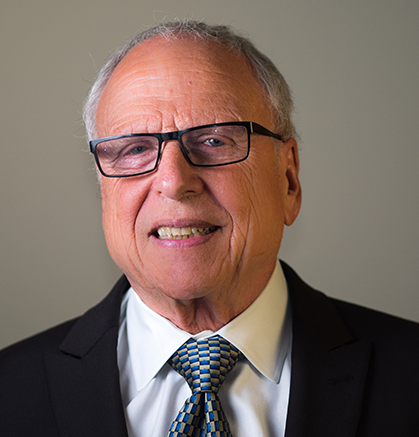Pfizer’s vaccine for COVID-19 is out the door and making its way into the arms of America’s frontline essential workers, nursing home residents and politicians. Moderna’s vaccine was approved on Dec. 22 — quickly increasing access to vaccination.
Approximately 2 million doses have already been shipped to health care facilities across the country, with an additional 20 million expected by the end of the year, federal officials estimate. However, only a fraction of individuals had been vaccinated so far.
With a goal of getting 70 percent of the U.S. population vaccinated, how long will that actually take? Arizona State University’s Eugene Schneller has a pretty good idea.
Schneller, a supply chain management professor with ASU’s W. P. Carey School of Business and a member of the Dean’s Council of 100 Distinguished Scholars, spoke with ASU Now about how the vaccines will be distributed and prioritized — and answers the question: How long will it take for hundreds of millions of people to receive their shots?
Eugene Schneller
Question: All 50 states have placed their orders with Pfizer for the COVID-19 vaccine, and the first batch is out the door. Realistically, how long will it take for everyone in the country to get vaccinated?
Answer: It’s a very complex process, and that’s probably worth saying upfront. It will take time and effort before the “corner drugstore” will have lots on hand and the skill to manage it. Many factors come into play.
Q: Each state is prioritizing who should get the vaccine first. Most agree that health workers and nursing home patients should get them first, but after that, it’s a mixed bag. Is allowing states to prioritize on their specific needs a good approach and why?
A: I think there should be a standardized protocol — applicable for all states. However, distribution has been left up to the governors. We have already agreed, front-line health care workers, other essential fields of work where maintaining the safety of the population is critical and those over 75 are at the front of the line.
Medical ethicists face these allocation problems frequently. Issues they should consider are age, co-morbidities — and one could make a case for children, but we do not yet have sufficient research.
Even though there have been 2 million doses shipped, only 556,000 as of Dec. 20 have been administered. That means only a small percentage of the population has been vaccinated. In order to reach 70 percent of our population, that means approximately 230 million people will have to get vaccinated in order for it to be effective.
Q: How long do you think it will take to reach that goal?
A: I have heard many projections. There is a complex supply chain that requires consideration. And the disruptions are difficult to predict. If you look at the Northeast (earlier this month), where there was a significant blizzard; vaccine shipping and distribution plans required revision. A plane sliding off the runway might have spelled disaster for thousands of doses.
And speaking of the cold, there’s a “cold chain” issue at play here. The vaccine has to be kept at a certain temperature. Pfizer requires 70 degrees below zero, and Moderna requires 20 degrees below zero. Once the dry ice is loaded onto a cooler, it lasts only three to four days. So how do you transport that to a remote place like a Native American reservation or other hard to reach places?
One dry ice maker in Massachusetts recently said they are working nonstop to facilitate product for COVID-19 storage. They’ve never had to produce that much dry ice, ever. Often in these situations, counterfeit or “gray” market products will rear their heads, so security of the supply chain is crucial. And, of course, there is a need to protect the health care workers from those in the queue who may be infected. So there are also other supply chains to consider in distributing the vaccine: raw materials for the syringes, masks, rubber gloves, etc.
Another consideration is getting people such as doctors, pharmacists, nurse practitioners and physician assistants properly trained to administer this vaccine. I’m sure that will get better as they move forward in this process, but that takes time. There will be a huge learning curve to all of this.
My best guess is that it won’t be until the spring, at the earliest, until we reach the 70 percent mark.
Q: Anything else the public should consider while they wait for their shots?
A: I’m sure policy issues will arise from this. Will we develop a policy for the border? For example, how to manage immigrants and tourists? Will they receive a certificate for the vaccination? Do we protect ourselves by protecting others? Will “vaccine nationalism” threaten global security? And of course, there is the COVID-19 — a very powerful and unpredictable enemy. As we learn more about the length of protection provided by the different vaccines, we may need to make changes in the schedule for revaccination. And, of course the recent mutation in COVID-19 requires vigilance — as future mutations are likely.
Top photo courtesy of Pixabay.com
More Science and technology

How AI is changing college
Artificial intelligence is the “great equalizer,” in the words of ASU President Michael Crow.It’s compelled industries, including higher education, to adapt quickly to keep pace with its rapid…

The Dreamscape effect
Written by Bret HovellSeventh grader Samuel Granado is a well-spoken and bright student at Villa de Paz Elementary School in Phoenix. But he starts out cautiously when he describes a new virtual…

Research expenditures ranking underscores ASU’s dramatic growth in high-impact science
Arizona State University has surpassed $1 billion in annual research funding for the first time, placing the university among the top 4% of research institutions nationwide, according to the latest…

